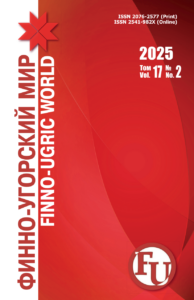Original article
DOI: 10.15507/2076-2577.013.2021.03.293-307
100 years of the Mari fine arts: ethnographic realism (1920–1930)
Elvira M. Kolcheva
Kazan State Institute of Culture,
Kazan, Russia
Introduction. The article is the first in a series of publications dedicated to the 100th anniversary of the Mari autonomy and the fact of the emergence of professional visual arts among the Mari people. The author regards it as a systemic element of national-ethnic culture, which performed the function of ethno-cultural reflection by artistic means throughout the entire century, in which four major stages and corresponding stylistic forms can be traced. The article describes the initial stage of the Mari fine arts of the 1920s – 1930s.
Materials and Methods. The main material was the collection of art and ethnographic works of the 1920s–1930 found in the funds of the National Museum of the Republic of Mari El. The author used various methods: historical research, art history analysis of works of art, as well as the author’s own method of structural and archetypal analysis.
Results and Discussion. The first art institutions appeared in the mountainous Mari region at the turn of the 1910–1920 thanks to the artist A.V. Grigoriev, who together with his associates later founded the Association of Artists of Revolutionary Russia in Moscow. The systematic institutionalization of the Mari fine arts began in the second half of the 1920, which was facilitated by the activities of the Mari Regional Society of Local History and the Central Mari Museum in the town of Krasnokokshaisk. The founders of the Mari fine arts were the invited artists from Kazan, namely P. A. Radimov, G. A. Medvedev, V. K. Timofeev, M. M. Vasilyeva, the first Mari artists K. F. Egorov and E. D. Atlashkina, and P. G. Gorbuntsov. With the beginning of the “Great Terror” period, the first stage of the Mari art was interrupted, and socialist realism replaced ethnographic realism.
Conclusion. The development of the fine art of the Mari at the initial stage was stimulated by the Mari Regional Society of Local History and the Central Mari Museum represented by V. A. Mukhin (Savi), V. M. Vasiliev, T. E. Evseev. Their educational interests, combined with the documentary-oriented program of the Association of Artists of Revolutionary Russia, contributed to the formation of such a stylistic form as ethnographic realism, which became the first artistic form of ethnocultural reflection by the means of fine arts.
Keywords: Mari fine art of the 1920s-1930s, ethnographic realism, T. Evseev National Museum of the Republic of Mari El
For citation: Kolcheva EM. 100 years of the Mari fine arts: ethnographic realism (1920–1930). Finno-ugorskii mir = Finno-Ugric World. 2021;13;3:293–307. (In Russ.). DOI: 10.15507/2076-2577.013.2021.03.293-307.
Information about the author
E. M. Kolcheva – Candidate Sc. {Art History}, Associate Professor, Department of the Museology, Cultural Studies and Art History, Kazan State Institute of Culture, elviramk@mail.ru, https://orcid.org/0000-0002-3058-5308






















